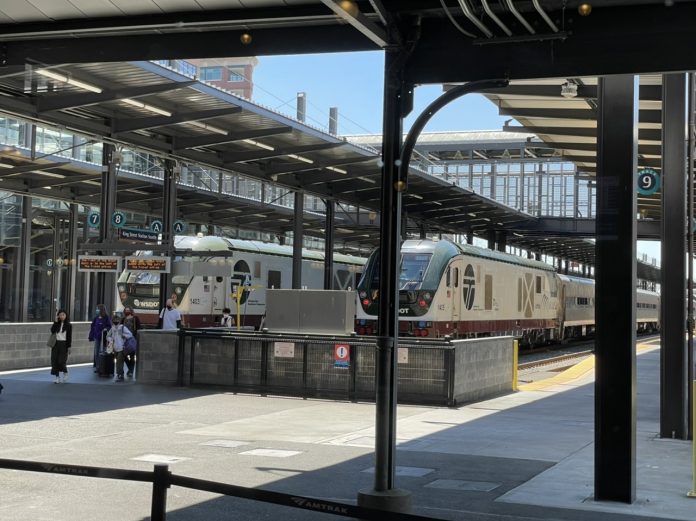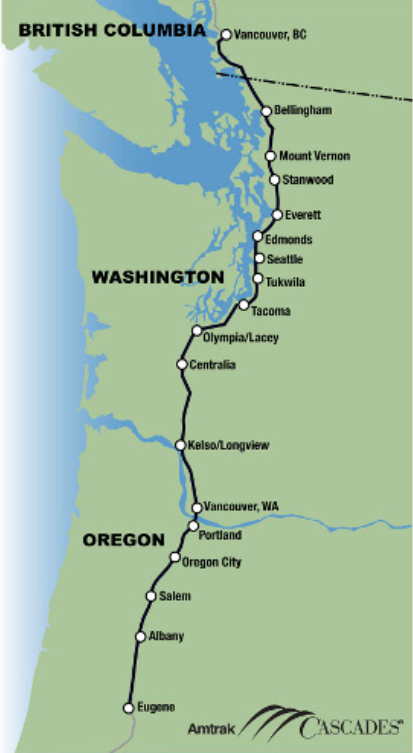
Amtrak hit an all-time record high for annual ridership, providing 34.5 million rides nationwide from October 2024 through September 2025, the company announced last week, up 5% from the previous year. Amtrak Cascades, the regional corridor that runs between Eugene, Oregon and Vancouver, B.C., also hit a record high, reporting 1.4% growth and coming in just short of the million-ride mark for the year.
Amtrak Cascades achieved that high water mark despite needing to suspend rail service for two weeks in March while it pulled aging Horizon trains cars out of service. For now, the Cascades fleet is operating with Amfleet I cars pulled in from the Northeast. Amfleet I cars are also nearing retirement age, but in mid-2026 Amtrak is planning to begin rolling out its new Airo trainsets, which will upgrade capacity and service quality.
Considering the boost from new and improved Airo trainsets, Amtrak Cascades could easily chug across the million-ride milestone in the next fiscal year. That would put the line in select company among Amtrak’s routes and start to give the popular Capitol Corridor route in California a run for its money.
As it stands, six Amtrak services attracted more than 1 million rides over the last year. Amtrak Cascades is the seventh busiest service, and the nearest to joining the million club. The top two services for ridership are effectively the same corridor: Acela runs the same route as Northeast Regional, but with faster trains and fewer stops.
| Ridership, FY25 | Ridership, FY24 | % change | |
| Northeast Regional | 12,018,536 | 10,794,566 | 11.3% |
| Acela | 3,153,621 | 3,238,130 | -2.6% |
| Pacific Surfliner, CA | 2,043,059 | 1,983,011 | 3.0% |
| Empire South, NY | 1,351,223 | 1,358,558 | -0.5% |
| Keystone, PA | 1,330,349 | 1,283,951 | 3.6% |
| Capitol Corridor, CA | 1,138,753 | 1,032,633 | 10.3% |
| Amtrak Cascades | 951,397 | 938,439 | 1.4% |
The Cascades line wasn’t the only service forced to pull Horizon train cars out of service, but it did account for 26 of the 70 cars. Service on the Downeaster, Hiawatha, and Borealis lines were also affected. The Hiawatha and Downeaster both saw ridership drops that were likely related to the disruption.
The Borealis, as a new service between Saint Paul, Minnesota and Chicago launched midway through 2024, did not have high baseline to disrupt. In fact, it led all lines with 140% growth, surpassing 212,000 boardings.
Ridership on the Cascades likely remained high in large part due to the two extra runs that were added between Seattle and Portland in 2023, bringing the total number of runs between Stumptown and the Emerald City to 12, along with the two runs on the Coast Starlight down to California.

Systemwide, Amtrak said that it has increased network capacity by 4.3% “despite the challenges of an aging fleet.”
“These results show what’s possible when we lead with purpose,” Amtrak President Roger Harris said in a statement. “By prioritizing reliability and the customer experience, we’re laying the foundation for the next generation of passenger rail in America.”
Along with ridership records, Amtrak also set ticket revenue records, pulling in $2.7 billion, which is 10.4% higher year-over-year. Overall, operating revenue was up 9.1%, and Amtrak said it expects to turn an operating profit by 2028.
Capital investments increased, too, hitting a record $5.5 billion – up nearly 25% year-over-year. Many of those dollars are due to the 2021 Infrastructure Infrastructure and Jobs Act (IIJA), passed under President Joe Biden and set to expire next fall.
On the other hand, the Trump administration is also seeking to claw back billions in grant funding for a key Amtrak Gateway rail tunnel in New York City, which would leave Northeast rail service with a huge pinch point and the liability of an aging tunnel under the Hudson River. Trump has claimed he has terminated the project, but it’s not clear if the Department of Transportation is on the same page.
Among the major projects that did receive funding was Seattle’s new $300 million expansion of its SoDo rail yard, which will help maintain its growing Airo fleet in the future.
“This includes $1.1 billion for track, catenary, signal, and structural maintenance, plus progress on major bridge, tunnel and station projects like the Portal North Bridge, Connecticut River Bridge, East River Tunnel, and William H. Gray, III 30th Street Station in Philadelphia,” Amtrak wrote. “Rail yard upgrades to support the new Airo fleet advanced in Seattle and along the East Coast. Station modernization and Americans with Disabilities Act (ADA) compliance efforts, which included more than $182 million invested in FY25 alone, continued nationwide—making rail travel more accessible to millions.”
State support is also boosting service on many of Amtrak’s most popular lines.

Washington State lawmakers have charted a path to double Amtrak Cascades service, but it’s not yet clear if they intend to actually fund that expansion. Their goal-setting legislation aims to cut the trip time from Seattle to Portland to 2.75 hours or less and to boost service to 14 daily trips with 88% on-time performance by 2035. The goal for trip time service north to Vancouver is 3 hours and 20 minutes. The speed goals would be about 25% faster than existing service, and the reliability targets would be a huge upgrade.
The new Airo trains are faster and built to top out at 125 miles per hour, though most Cascades trackage cannot accommodate such speeds without further upgrades. Such improvements would need to be negotiated with BNSF, the freight rail company that owns the route. Current federal regulations cap speeds at 79 miles per hour on most of the Cascades corridor.

Several leaders across Cascadia have been pushing for more dramatic upgrades by building a brand new bullet train corridor to link the Portland, Seattle, and Vancouver metropolitan areas. Government officials and business leaders organized under the Cascadia Innovation Corridor are pushing a plan that could cut the trip from Seattle to Portland or Vancouver, BC to just one hour.
The Washington State Department of Transportation has conducted preliminary studies on the “ultra high-speed rail” concept, and is working on a service development plan it aims to complete by 2028.
While ambitious and holding the potential to attract huge ridership by competing with airline service, high-speed rail will be a very costly undertaking. Plus, permitting and constructing such a complex project would take a long time, particularly if Cascadia was to run into similar hurdles that have hampered California high speed rail.
Given the risks, obstacles, and opportunity costs, some rail groups have pushed state leaders to keep their primary focus on upgrading Amtrak Cascades service for now. Bill Moyer, leader of Solutionary Rail, has even painted the bullet train plan as “the very definition of a boondoggle” that should be bypassed entirely.
Pursuing a Cascadia bullet train does not necessarily need to be mutually exclusive with goals to upgrade Amtrak Cascades service by 2035. It appears highly unlikely that a bullet train would be ready to begin operating by then, but Amtrak’s record-setting figures show ridership demand is sky high here and now.
Doug Trumm is publisher of The Urbanist. An Urbanist writer since 2015, he dreams of pedestrian streets, bus lanes, and a mass-timber building spree to end our housing crisis. He graduated from the Evans School of Public Policy and Governance at the University of Washington in 2019. He lives in Seattle's Fremont neighborhood and loves to explore the city by foot and by bike.


